The term “middle class” in Canada often evokes images of financial stability, homeownership, and the ability to comfortably manage living expenses while saving for the future. But what truly defines middle class income in Canada, especially in 2025?
With rising living costs, varying income levels across provinces, and shifting economic conditions, understanding where you stand in the financial spectrum is crucial. This guide explores what it means to be middle class in Canada, how it’s measured, and the factors that influence its definition.
By examining provincial differences, cost of living comparisons, and the challenges faced by Canadians today, we aim to provide a clear perspective on where middle-class income stands and how it may evolve in the coming years.
What Is Considered Middle Class Income in Canada?

Middle class income in Canada is defined based on household earnings that fall within a specific range of the national median income. According to the Organization for Economic Co-operation and Development (OECD), the middle class is identified as households earning between 75% and 200% of the median household income after taxes.
Based on 2025 statistics, this income range is approximately $52,875 to $141,000 annually. These figures provide a benchmark for understanding where households stand economically across the nation.
For many Canadians, being part of the middle class means more than just an income bracket, it represents financial security and access to opportunities such as homeownership, education, and a decent standard of living. However, this status can vary significantly depending on the cost of living and average wages in different regions.
In provinces like Ontario and British Columbia, middle class earnings are often stretched thin due to high housing costs and living expenses. Conversely, regions like the Prairies may offer a more affordable lifestyle within the same income range. Understanding this financial bracket is key to assessing economic health and planning for the future in Canada.
How Is Middle Class Income Measured in Canada?
Middle class income in Canada is measured using various economic indicators that reflect household earnings and living costs. The primary factors include:
- Median Household Income: The middle point of all household earnings, which helps establish the middle class range.
- After-Tax Income: The take-home pay after federal and provincial taxes provides a clearer picture of disposable income.
- Cost of Living Adjustments: Variations in expenses like housing, groceries, and transportation across provinces.
In addition, OECD standards use a percentage of the median income to define middle class status, setting it between 75% and 200% of the median income. This methodology is crucial for identifying economic stability and understanding where Canadian households stand financially.
What Are the Provincial Differences in Middle Class Income?

Income levels in Canada vary widely based on provincial economies, employment opportunities, and living costs. Provinces such as Alberta and Ontario tend to have higher middle class income ranges due to stronger job markets and higher costs of living, while Manitoba and Saskatchewan offer more affordability within the same bracket.
The table below highlights the differences:
| Province | Middle Class Income Range (2025) | Cost of Living Index |
| Ontario | $60,000 – $150,000 | High |
| Alberta | $65,000 – $160,000 | Moderate |
| British Columbia | $70,000 – $170,000 | High |
| Quebec | $55,000 – $140,000 | Moderate |
| Manitoba | $50,000 – $135,000 | Low |
These figures reflect how location impacts what is considered middle class, with some provinces demanding higher incomes to maintain the same standard of living.
How Does Middle Class Income Compare to the Cost of Living in Canada?
The cost of living in Canada significantly influences what is considered middle class. Essential expenses such as housing, transportation, and food vary by province, affecting how far middle class income can stretch.
In provinces like British Columbia and Ontario, high property costs and utilities can consume a substantial portion of household income, while regions like Manitoba and Saskatchewan provide more breathing room for savings and discretionary spending.
Below is a comparison of average costs in major provinces:
| Province | Average Rent (2-bedroom apartment) | Monthly Utilities | Grocery Costs (monthly) |
| Ontario | $2,100 | $250 | $400 |
| Alberta | $1,800 | $220 | $380 |
| British Columbia | $2,400 | $280 | $420 |
| Quebec | $1,500 | $200 | $350 |
| Manitoba | $1,200 | $180 | $340 |
The cost of living index highlights why middle class income may feel stretched in certain areas while more comfortable in others.
What Are the Different Income Classes in Canada?
Income classes in Canada are segmented into four primary categories: Lower Class, Middle Class, Upper Middle Class, and Upper Class.
These divisions are based on annual pre-tax income and reflect varying standards of living and financial stability. Understanding these classes helps Canadians assess where they stand economically. The table below provides an overview of income ranges for each class:
| Income Class | Annual Income Range (2025) |
| Lower Class | $0 – $57,375 |
| Middle Class | $57,375 – $114,750 |
| Upper Middle Class | $114,750 – $253,414 |
| Upper Class | $253,414 and above |
The lower class typically includes minimum-wage earners and individuals on social assistance, while the middle class represents the majority of working Canadians with stable jobs.
Upper middle class households often have dual incomes with higher education levels, and the upper class consists of high-income earners, including business owners and executives. These classifications help measure economic health and policy effectiveness across Canadian regions.
How Are Taxes Calculated for Middle Class Income in Canada?

In Canada, taxes for middle class income are calculated based on federal and provincial tax brackets. The government applies different tax rates to portions of an individual’s income, resulting in a progressive tax system.
Here’s a breakdown of the 2025 federal tax rates for middle class income:
- 15% on the portion of income from $0 to $57,375
- 20.5% on income from $57,375 to $114,750
- 26% on income from $114,750 to $177,872
- 29% on income from $177,872 to $253,414
Provincial taxes are applied separately and vary across regions. Middle class families also benefit from tax credits and deductions, such as the Canada Child Benefit and RRSP contributions, which can reduce taxable income. Understanding these rates helps Canadians optimize their financial planning and maximize annual savings.
What Is the Average Income in Canada and How Does It Compare to Middle Class?
The average income in Canada for 2025 is projected at around $70,000 pre-tax, while the median after-tax income is approximately $66,800.
These figures sit comfortably within the middle class range but vary significantly by province.
The table below shows the average incomes across major provinces:
| Province | Average Income (2025) |
| British Columbia | $66,232 |
| Alberta | $74,237 |
| Ontario | $63,369 |
| Quebec | $57,506 |
| Manitoba | $58,500 |
While the average income represents the typical earnings of Canadians, the middle class range ($57,375 to $114,750) allows for more financial stability and savings.
In provinces with higher costs of living like British Columbia and Ontario, average income may not stretch as far compared to regions like Manitoba or Quebec.
What Are the Living Wages for Canadian Families in 2025?
A living wage in Canada is the income required to cover basic living expenses, such as housing, food, and transportation, while allowing for modest savings. It is calculated based on family size and regional costs of living.
For 2025, the estimated living wages are shown below:
| Family Type | Estimated Living Wage (2025) |
| Single Person | $45,000 |
| Couple (No Children) | $50,000 |
| Family of Four | $60,000 – $70,000 |
These figures highlight the income needed to maintain financial stability without relying on debt. In high-cost provinces like Ontario and British Columbia, the living wage requirement is on the higher end, while in Manitoba and Saskatchewan, it is more affordable.
Middle class families often surpass these living wage thresholds, but high costs can still strain budgets in expensive regions.
What Jobs Typically Fall Under Middle Class Income in Canada?

Certain professions in Canada typically fall within the middle class income range, offering financial stability and the potential for upward mobility. These jobs are often linked to skilled trades, health care, and technical fields.
Below is a list of common middle class jobs and their average annual earnings in 2025:
| Profession | Average Annual Income (2025) |
| Pharmacist | $110,000 |
| Software Developer | $95,000 |
| Electrician | $75,000 |
| Construction Manager | $105,000 |
| Marketing Manager | $90,000 |
| Human Resources Manager | $85,000 |
These roles often require specialized education or training and are distributed across various provinces with some regional income variations. Many of these professions also provide pathways for career advancement, which can lead to upper middle class status.
How Does Income Distribution Work in Canada?
Income distribution in Canada is measured by dividing the population into percentiles based on earnings. This helps to identify economic inequality and the concentration of wealth.
Key points of the income distribution are:
- Top 1% earn above $315,911
- Top 5% earn above $162,210
- Top 10% earn above $125,942
- Median Income (50%) is around $46,151
- Bottom 25% earn less than $22,465
The majority of middle class earners fall between the 50th and 75th percentiles. Income distribution analysis helps policymakers understand economic disparities and develop targeted support for lower and middle class Canadians.
Is Homeownership Still a Reality for the Middle Class in 2025?
Homeownership remains a significant aspiration for many middle class Canadians, but it is increasingly challenging in 2025. Rising real estate prices, especially in major cities like Toronto and Vancouver, have pushed homeownership out of reach for many middle class families.
Mortgage rates have also increased, making monthly payments higher than in previous years. According to the Spring Financial report, many Canadians are turning to longer mortgage terms and government programs to enter the housing market.
While possible, homeownership now requires more strategic financial planning and often involves relocating to more affordable regions outside of urban centers.
What Challenges Does the Canadian Middle Class Face in 2025?
In 2025, middle class Canadians continue to face several economic challenges:
- Rising Cost of Living: Increasing housing costs and inflation make it harder for families to save and invest.
- Stagnant Wage Growth: While the cost of living rises, income growth has not kept pace in many sectors.
- High Debt Levels: Many Canadians carry significant debt loads, limiting financial flexibility.
- Homeownership Barriers: Skyrocketing real estate prices prevent many middle class families from purchasing homes.
- Economic Uncertainty: Global economic shifts and market volatility add to financial insecurity.
These challenges highlight the growing difficulty of maintaining a middle class lifestyle in Canada, particularly for younger generations entering the workforce.
How Can Canadians Achieve and Maintain Middle Class Status?
For Canadians aiming to achieve or maintain middle class status, strategic financial planning is crucial:
- Budgeting and Saving: Establishing a budget and setting aside emergency savings can provide stability.
- Investing in Education: Higher education often leads to better-paying job opportunities.
- Homeownership Strategies: Exploring government programs for first-time buyers can make homeownership more accessible.
- Smart Investments: Investing in stocks, mutual funds, or real estate can help grow wealth over time.
- Government Benefits: Leveraging programs like the Canada Child Benefit and Old Age Security can supplement income.
These strategies help Canadians navigate economic challenges and secure their position in the middle class.
Middle Class Income vs. Average Income in Canada

Understanding the difference between middle class income and average income is essential. The average income in Canada, which is around $70,000 pre-tax, represents the typical earnings of working Canadians, while middle class income ranges more broadly, from $52,875 to $141,000.
Key differences include:
- Middle Class Income: Reflects a range based on median earnings, with a focus on affordability and stability.
- Average Income: A simple average that includes high earners and low-income households, potentially skewing the data.
- Cost of Living Impact: Middle class income is more sensitive to regional cost of living variations.
These distinctions are important for understanding economic policies and financial stability in Canada.
Future Outlook: Is the Middle Class Growing or Shrinking in Canada?
As of 2025, the future of Canada’s middle class remains uncertain. Economic experts suggest that the middle class is shrinking due to rising living costs and stagnating wages.
Housing prices and inflation have outpaced income growth, making it harder for families to maintain their lifestyle. The government’s tax policies and social benefits may play a crucial role in determining whether the middle class can stabilize or continue to decline.
What Government Benefits Are Available for Middle Class Canadians?
Middle class Canadians have access to several government benefits designed to provide financial stability and support.
These include:
- Canada Child Benefit (CCB): Provides monthly, tax-free payments to families with children under 18.
- Canada Pension Plan (CPP): A government-funded retirement plan based on contributions made during one’s working years.
- Old Age Security (OAS): Monthly payments to seniors aged 65 and older, with additional benefits for low-income seniors.
- Employment Insurance (EI): Offers temporary financial assistance for unemployed Canadians who have lost their job through no fault of their own.
These benefits help supplement middle class income, especially during periods of unemployment, retirement, or while raising children. They also provide financial relief that allows for better long-term planning and security.
Conclusion
Understanding what defines middle class income in Canada is crucial for financial planning and assessing one’s economic stability. As we saw, the middle class is generally defined as earning between $52,875 and $141,000 annually, depending on the province and local cost of living.
Rising housing costs, inflation, and regional differences make achieving and maintaining middle class status more challenging in 2025.
However, strategic financial planning, investment in education, and leveraging government benefits can help Canadians navigate these economic pressures.
Moving forward, policies aimed at reducing income inequality and supporting middle class families will be vital for sustaining financial stability and growth in Canada.
FAQs
What salary is considered middle class in Canada?
In Canada, middle class income typically ranges between $52,875 and $141,000 per year, depending on the cost of living in various provinces. This range represents 75% to 200% of the median household income.
Does middle class income vary by province in Canada?
Yes, middle class income varies by province due to differences in average earnings and living costs. For example, it is generally higher in Ontario and Alberta compared to Manitoba or Quebec.
How has middle class income changed in Canada over the last decade?
Middle class income in Canada has faced pressure from rising housing costs and stagnant wage growth. Over the last decade, the gap between middle class earnings and living expenses has widened.
What is the difference between middle class and average income in Canada?
Middle class income is defined as a range based on median earnings, while average income is a simple average of all Canadian earnings. Middle class income better reflects economic stability and living standards.
Is it possible to live comfortably on a middle class income in Canada?
Living comfortably on a middle class income is possible, but it largely depends on location. In high-cost areas like Vancouver or Toronto, middle class families may struggle compared to those in less expensive regions.
How does the cost of living affect middle class status in Canada?
The cost of living significantly impacts middle class status, as higher expenses for housing, transportation, and food can stretch household budgets thin. This is especially true in major cities.
Are government policies helping the middle class in Canada?
Government policies, such as tax breaks and housing incentives, are aimed at supporting the middle class. However, many argue that more targeted measures are needed to address the rising cost of living.




